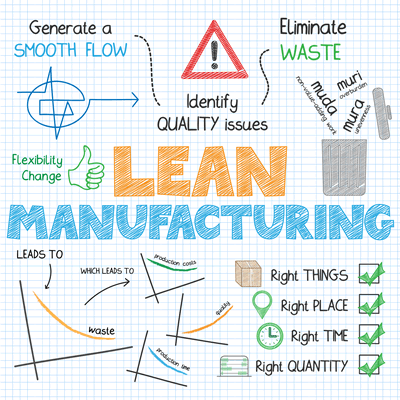April 24, 2018
Avoid These 8 Types of Waste to Improve Your Lean Manufacturing Process
SHARE THIS POST
 Lean manufacturing is a management philosophy that aims to reduce waste in all its forms from the production process. While the seeds of this approach can be found in the writings of Benjamin Franklin and Henry Ford, it was executives at the Toyota Corporation who codified and expanded what we call the lean manufacturing process. Toyota’s managers identified seven (later eight) basic types of waste, proposed solutions for each, and used their system to turn Toyota from a small manufacturer to one of the largest in the world.
Lean manufacturing is a management philosophy that aims to reduce waste in all its forms from the production process. While the seeds of this approach can be found in the writings of Benjamin Franklin and Henry Ford, it was executives at the Toyota Corporation who codified and expanded what we call the lean manufacturing process. Toyota’s managers identified seven (later eight) basic types of waste, proposed solutions for each, and used their system to turn Toyota from a small manufacturer to one of the largest in the world.
The Eight Types of Waste
Mantec, a Pennsylvania-based consulting firm that helps manufacturers with efficiency and compliance, identifies eight potential types of waste, which can be abbreviated using the acronym “DOWNTIME.” They are identical to the seven formulated by Toyota, with the added insight of workers’ wasted potential.
- Defects: Time wasted to inspect and correct errors.
- Overproduction: Producing ahead of demand.
- Waiting: Time workers waste waiting for their colleagues or materials.
- Non-Utilized Skills: Failure to recognize and embrace employees’ full potential.
- Transportation: Unnecessary shipping, packing, and loading.
- Inventory: Money and storage space wasted on unused materials.
- Motion: Extra walking or other movement caused by a poorly designed work area.
- Extra Processing: Wasted labor due to inefficient tools, engineering, or management.
The Importance of Kaizen
“Kaizen” is the Japanese word for “improvement.” In relation to the lean manufacturing process, it refers to the idea that there is no such thing as “good enough” – there is always the opportunity for greater efficiency. Even if a production line couldn’t be smoother, managers must prepare for the future and consider long-term stability.
5S and Kanban
Lean manufacturing only offers managers an ideological framework to improve their organization; diagnosing problems and implementing their solution are left to the executives. However, most devotees of lean manufacturing agree that two basic principles – 5S and Kanban – can elegantly address many of the sources of waste.
5S is a set of five guidelines for cleanliness, so named because they all begin with ‘S’: Sort, Set in Order, Shine, Standardize, and Sustain. They essentially state that workplaces should be organized and spotlessly clean for not only efficiency, but also workers’ safety and comfort, and there should be measures in place to guarantee that the cleanliness is maintained.
Kanban is a system that guarantees production never gets ahead of distribution and consumption. Kanban cards – once actual cards, now often digital signals – are used to tell management that a material has run out and must be replenished. Ordering goods and commissioning work only after the last round is complete ensures that storage space is never wasted, time is never spent on projects that don’t sell, and the organization is more resilient to change.
Improve Your Lean Manufacturing Strategy
Contact us today to see how we can help improve your lean manufacturing strategy!
Search
Categories
Get a consultation
Related Posts
The 3 Distinct Advantages of Hydraulic Powered Pumps
Recently, C. H. Reed helped a major printing operation install a new ink pumping system. The new system needed to transfer four colors of high viscosity, heat-set ink to their three presses, drawing the ink from multiple 5,000…
Simple Ways to Reduce Waste in Your Spray Finishing System
In today’s demanding manufacturing landscape, it can be convenient to adopt a “cut-costs-at-all-costs” mentality, justifying questionable means for the sake of leaner production, a lower bottom line and increased profitability. Regrettably, those efforts can interfere…
What You Need to Know About Air-Powered Pressure Washers
Pressure washers are great solutions for your average cleaning applications, but what tool do you turn to for your more challenging applications? There are many instances where it is simply impossible to use a traditional…